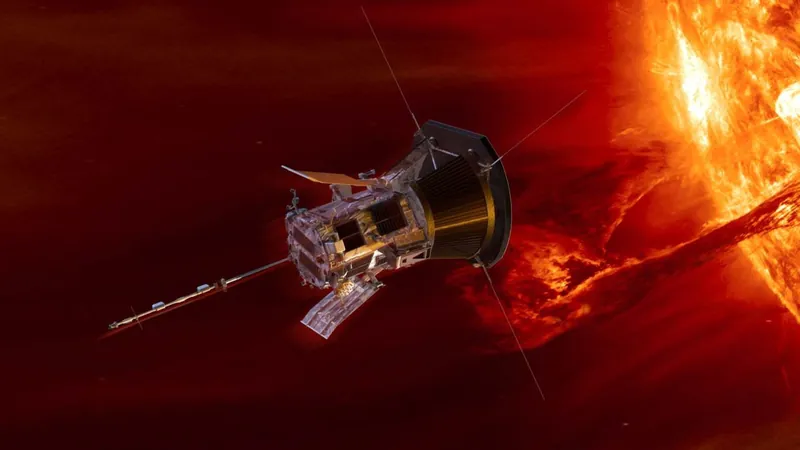
NASA's Parker Solar Probe: Unlocking the Secrets of the Sun’s Fiery Atmosphere!
2024-11-18
Author: Lok
NASA's Parker Solar Probe has recently made an astounding leap in solar research, sailing perilously close—within just 234 miles (376 kilometers)—of Venus on November 6. This daring flyby was a gravity-assist maneuver, designed to boost the probe's speed and alter its orbit closer to the sun. This strategic move is a stepping stone in its mission to uncover the age-old enigmas surrounding our star.
Before this latest maneuver, Parker had already completed several passes near the sun. However, its recent encounter brought it within about 3.8 million miles (6 million kilometers) of the solar surface, a distance that is less than nine times the radius of the sun! At the moment of its closest approach, Parker soared through space at a breathtaking speed of nearly 435,000 mph (700,000 km/h)—a record that makes it the fastest human-made object to date. To put this into perspective, that’s about 0.06% of the speed of light!
The main objective of the Parker Solar Probe is to explore the mysteries of the solar corona, the sun’s outer atmosphere. Historically, researchers have observed that while the visible surface of the sun, known as the photosphere, maintains temperatures around a few thousand kelvins, the corona inexplicably reaches temperatures soaring into the millions of kelvins. This phenomenon raises a puzzling question: How can the corona be so much hotter than the surface?
It's known that typical heat transfer processes can't explain this temperature disparity. By conventional physics, the cooler photosphere should not be able to heat the hotter corona, as it contradicts the second law of thermodynamics. Hence, scientists propose that magnetic fields play a pivotal role in this heating process.
An interesting aspect emerges from the study of helium within the sun. Helium constitutes about 25% of the sun’s mass and behaves differently at varying temperatures. When cooled, helium loses one of its two electrons, entering a state that readily emits radiation, keeping the sun glowing while maintaining a degree of thermal control. However, as helium becomes fully ionized when heated, it becomes significantly less capable of radiating energy, effectively trapping heat in the corona. This ‘evaporation’ process allows the corona to reach its high temperatures with minimal energy input—roughly 1 kilowatt per square meter, which is astonishingly efficient.
To delve deeper into these mysteries, the Parker Solar Probe is equipped with four advanced instrument suites—FIELDS, WISPR, ISʘIS, and SWEAP. These systems collaborate to analyze the corona, the solar wind (a stream of charged particles erupting from the corona), and the photosphere, piecing together a comprehensive understanding of solar behavior.
One groundbreaking discovery from Parker is the identification of peculiar magnetic energy waves named switchbacks. These switchbacks originate in the tumultuous photosphere, where energetic plasma plumes rise and fall continually. Interactions occur when regions of magnetic energy tangle, creating chaotic field lines. When these lines interact, they can disconnect and reconnect in a dramatic S-shaped curve known as a switchback, which then travels outward into the corona, releasing energy upon dissipation.
Researchers believe that switchbacks are crucial—if not the most essential mechanism—by which the sun heats its corona. As the Parker Solar Probe continues its mission, further revelations await, promising to deepen our understanding of solar dynamics and the forces shaping our star, ultimately paving the way for advancements across numerous scientific fields, from solar energy to space weather forecasting. Buckle up as this expedition could redefine our knowledge of the sun!


 Brasil (PT)
Brasil (PT)
 Canada (EN)
Canada (EN)
 Chile (ES)
Chile (ES)
 España (ES)
España (ES)
 France (FR)
France (FR)
 Hong Kong (EN)
Hong Kong (EN)
 Italia (IT)
Italia (IT)
 日本 (JA)
日本 (JA)
 Magyarország (HU)
Magyarország (HU)
 Norge (NO)
Norge (NO)
 Polska (PL)
Polska (PL)
 Schweiz (DE)
Schweiz (DE)
 Singapore (EN)
Singapore (EN)
 Sverige (SV)
Sverige (SV)
 Suomi (FI)
Suomi (FI)
 Türkiye (TR)
Türkiye (TR)